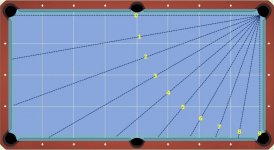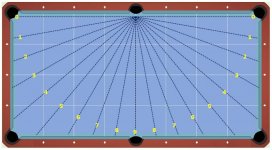It's silly to state that any aiming system must take into account all details pertinent to any possible shot. Such as SIT, CIT, english, deflection, squirt, squerve, masse' effect, ect. Just as it would be silly to state that any diamond system for kicking must take into account all the above plus, cloth friction, cloth tightness, rail material, diamond placement accuracy (varies from man. to manufacturer) ect.
WTH, I never said all that. How about having an estimated amount of compensation for stun, or slow shots for instance? Is that so impossible? At least get someone in the ballpark. Joe Tucker does it, Ekkes does it, why can't everybody else?
Also, as you know any diamond system is CRITICALLY dependent on spin/speed, or lack thereof depending on the system. They therefore have "calibration shots" which must be hit accurately, to understand how much spin to use. When you approach the limits of the system, again you need to compensate, because usually the function best in a middle range. Again, nice to have some instruction on how to compensate, and how much. Grady does this in his videos. So it is not impossible. Also many diamond system books will show you how to compensate for new or old cloth as well. You don't even need to know about the cushions and cloth many times, you just need to know if the table banks long or short. But then, you get a solution for that, most of the time. Ok, you will need feel, but you don't have to start way off in your estimations. Most of the factors you mention are total strawmen, and you know it, but others are vitally important!
But ok, lets say all of the above is stupid and wrong, why have any system at all? I mean the diamond system without calibration and compensations is COMPLETELY USELESS for billiards (except maybe for a usually narrow, optimal range). Sure you might luck in a billliard now and then, but you won't be accurate. You might as well forget the diamonds completely and play entirely by feel. It's not much difference in the straight in pots. Any idiot can tell you the approximate shotline after playing intensively for a year or so. But the devil is in the details. Again, no details, not even essential ones like the ones I mention, means that the system is not much better for aiming than pure feel. The only benefit would then be the effect on the PSR. Again IMO.
The absolute minimum a commercial system can do (and by not doing it, it's imo not a system at all) is to show you HOW to compensate. In a pivot system, should you paralell shift, should you "extend the pivot" should you add backhand english etc. What about the diamond system, should you change speed, add low/high, add/remove spin etc. Some of these work better than others. Some can make the system fail completely. So, good to know, maybe? Just asking.

